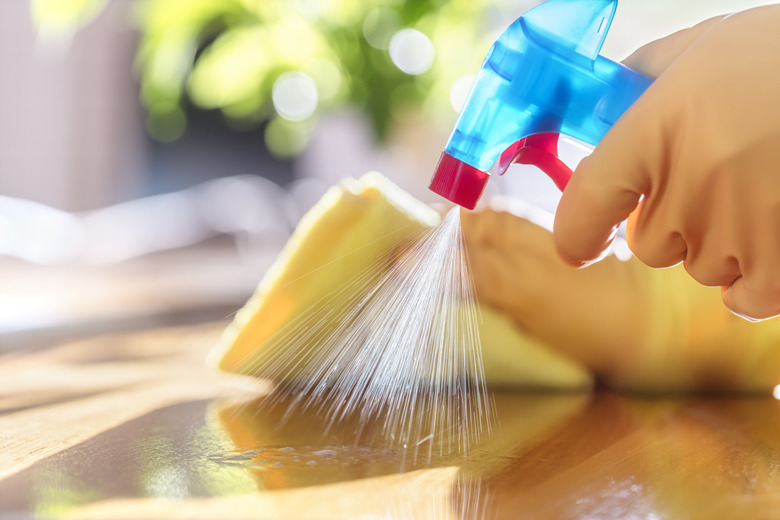The 11 Hidden Health Hazards In Your Home
We may receive a commission on purchases made from links.
No one thinks of their home as a health hazard — but the truth is that we fill it with chemicals and mechanical systems that, if left unchecked or unmaintained, could pose a major health risk. Although you may have a solid understanding of the known health hazards that are potentially present in homes — lead paint, radon, mold and carbon monoxide — there are many less obvious home health hazards that are sometimes hidden in plain sight. But with just a bit of know how, planning and keeping several items out of reach of children, you can keep all your family members safe from harm.
1. Asbestos Fiber Danger
1. Asbestos Fiber Danger
Admittedly, this is one of the health hazards you probably already know about, so why mention it? It's because asbestos is an issue that new homeowners often assume was resolved long ago, but this may not be the case.
If your home was built before 1980, there is a good chance that it contained asbestos and still might. Asbestos fibers are dangerous only when they become airborne and put you at risk of breathing them in — and prolonged exposure can potentially lead to mesothelioma, which is a type of lung cancer. This isn't an issue as long as the asbestos-containing materials remain intact, undamaged and undisturbed. As such, a lot of homeowners took the old "if it ain't broke, don't fix it" approach.
For example, that means that someone may very well have laid your vinyl kitchen floor over old asbestos tiles. If you rip up the floor, you may disturb asbestos. Try to learn as much as you can about your home's construction and renovation history. When in doubt, have a professional come out and check any questionable materials for you.
2. Scented Candles and Incense
2. Scented Candles and Incense
The obvious safety hazard presented by candles and incense is fire, but enjoying their delightful scents may also pose health problems. The chemicals used to create scents can cause indoor air pollution and may trigger asthma as well as migraines in some people.
Incense in particular often contains a chemical called benzene. Benzene can cause problems with bone marrow and red blood cells. Benzene can also cause irregular menstruation and may reduce the size of a woman's ovaries.
Candles don't tend to contain benzene, but their wicks do sometimes contain lead. Burning candles with lead in the wicks can easily raise lead levels in the air to a point that the Environmental Protection Agency (EPA) has deemed unsafe.
3. Your Couch Cushions
3. Your Couch Cushions
Starting in 1975, furniture manufacturers started adding flame-retardant chemicals to couches and other upholstered furniture. While it seemed like a good idea at the time, scientists later discovered that many of these flame-retardant chemicals have the potential to cause cancer.
Upon this discovery, the government didn't outright ban the use of these chemicals, but it did ask companies to minimize their use and clearly label furniture that contains them. As a result, the older your sofa, the more likely it is to contain harmful chemicals — and they hang around for a long time.
It's clearly not practical to toss out all your furniture and buy new, but you can still protect yourself. If you have furniture that may contain these chemicals, simply make sure you keep it in good repair. As your furniture wears, it releases more of these potential toxins, which are applied throughout the entire piece, including inside your couch cushions.
To stay as safe as possible, patch any rips or tears quickly. A rip or tear may expose an internal cushion that still contains high levels of chemical, so try to keep it covered. You can also minimize the amount of chemicals present in your furniture by replacing the cushions. Using slipcovers can also keep chemicals contained.
4. Firearms in the Home
4. Firearms in the Home
Although you're allowed to own firearms and keep them in your home if you wish, it's quite easy, however, for people who are familiar and comfortable with these weapons to let their guard down on occasion. You're only human, after all. Remember that it's not just young children who need protection from accessing firearms. Suicidal or unstable adults can also be vulnerable.
To protect yourself and others, it's necessary to remain vigilant as always when weapons are out. Store firearms unloaded and in a separate place from your ammunition. Limit who can locate the keys or who knows the combination to your gun safe and ammunition storage locations.
5. Clutter as a Health Hazard
5. Clutter as a Health Hazard
Clutter happens, and only a gifted few seem capable of avoiding it. (Looking at you, Marie Kondo.) The good news is that you don't have to avoid it altogether. You should, however, make an effort to keep stuff off the floors.
You may not think of clutter as a household hazard, but falls are a common source of household injury, and the risk greatly increases when there is more stuff on the floor. In addition to removing clutter from the floor, make sure you tuck away any electrical cords and secure area rugs that might slide.
It's also important to clear as much clutter as you can in other parts of your home. A tripping hazard is the most obvious problem created by clutter, but it's not the only one. Cluttered homes tend to burn faster during house fires given the massive amounts of available fuel. Clutter can also make it harder for firefighters to maneuver in the home to put out the flames.
6. Nonstick Cooking Pans
6. Nonstick Cooking Pans
This one is the subject of some debate. It's true that nonstick cookware can release up to 15 different toxins, two of which can cause cancer. It does so only when exposed to excessive amounts of heat, however. Normal cooking temperatures don't usually get high enough to create problems, so there's no need to replace all of your pots and pans.
If you're concerned about these chemicals, simply refrain from preheating your nonstick cookware without any food in it. Use only plastic cooking utensils to avoid scratching the nonstick coating. You can continue to safely use your nonstick cookware until it becomes scratched or the coating starts to peel away or flake off. Once the coating starts to flake, however, toxins are far more likely to leech out of the pan and into your food, so replace flaking pans promptly.
7. The Clothes You Wear
7. The Clothes You Wear
Food manufacturers are required to list every ingredient they put in your food, but clothing makers aren't required to do so. Older water-repellent and flame-retardant fabrics often contain formaldehyde, which can irritate the upper respiratory system. If you have older rain gear or flame-retardant fabrics in your closet, it's best to replace them with items made from natural fibers.
Exercise caution with dry-cleaned clothes as well. Dry cleaners sometimes use a cleaning chemical called perchloroethylene, which the EPA classifies as a possible carcinogen. If your clothes come back from the cleaners bearing a strong chemical smell, ask the cleaner to clean them again. Always remove dry cleaning from the plastic bag and air it out for a few days in your garage or outside.
Note that mothballs are simply not healthy for living things, including humans. If you feel the need to store your clothes with mothballs, use them properly by sealing them and your clothes in an airtight container. When removing the clothes from storage, wash them and air them out well.
8. Uninvited Pests and Critters
8. Uninvited Pests and Critters
You know that pesticides and poisons can be dangerous, but do you know that pests themselves can create health hazards? All pests shed skin and leave behind fecal matter, both of which can negatively affect your home's air quality and spread bacteria. Cockroaches are particularly gross and often aggravate asthma and are a common allergen. They also carry illnesses that can contaminate food. Mosquitoes carry a wide variety of viruses as well, from the West Nile virus to the Zika virus.
Although they may look less objectionable than cockroaches, furry rodents cause problems too. Mice, squirrels and other rodents can all carry E. coli bacteria, Lyme disease and salmonella. Mice also dribble a path of urine as they run through your house.
Pests can make your home unsafe by causing physical damage too. Rodents chewing through electrical wires can create a dangerous fire hazard. Carpenter ants and termites will destroy wood mercilessly and can create structural damage in floors, foundations and wooden framing.
9. Antibacterial Soaps and Sprays
9. Antibacterial Soaps and Sprays
Quite surprisingly, antibacterial soaps and cleaning products may actually do more harm than good. In 2016, the U.S. Food and Drug Administration (FDA) determined that many of the chemicals used to create antibacterial soaps and cleansers could cause health issues, including what they branded "hormonal effects."
The FDA promptly banned 19 such dangerous chemicals from antibacterial products with a special focus on the chemicals triclosan and triclocarban. Not only are some of these products potentially hazardous but there is also no data proving that they work any better than regular soap and water.
10. Standing Water
10. Standing Water
A child can drown in as little as 2 inches of water. Clearly, you'll need to take measures to keep them out of the swimming pool and make sure they're never in the bathtub unattended, but toddlers are inquisitive creatures who can find trouble in places that grown-ups never think to look.
To keep things as safe as possible, keep the lid on your toilet closed. Move your pet's water bowl to a place where a child cannot easily reach it and make sure to immediately empty any buckets you use around the house. Do so both inside and outside your home. Standing water outside can lead to drowning and an influx of mosquitoes that can potentially carry disease.
11. Recalled Products
11. Recalled Products
If a product you've purchased is recalled, it's important to have the item fixed or replaced. Admittedly, this can be quite inconvenient, especially if it means lugging large or heavy items back to the store or to a repair facility. As inconvenient as it is, however, safety recalls are important, and you should always address them promptly to avoid health and safety risks.
If a company knows you purchased its product, it may reach out to you and inform you of the recall. Companies that don't track all of its customers can't do this, so it's a good idea to keep an eye on product recalls yourself. To do so, register your email with the Consumer Product Safety Commission at cpsc.gov. After you register, it will alert you about recalls so you never miss an important one. You can also search for past recalls on the site.
References
- Centers for Disease Control and Prevention: Facts About Benzene
- Asbestos.com: Guide to Asbestos in the Home
- Building Performance Institute: Things You Should Know: Effects of Pests in Your Walls and Home
- U.S. Food & Drug Adminstration: FDA Issues Final Rule on Safety and Effectiveness of Antibacterial Soaps
- AARP: Health Hazards in Your Own Home
- National Home Security Alliannce: Safety at Home: 10 Common Safety Hazards Around the House
- Parents: 10 Hidden Health Hazards in Your Home
- WebMD: Common Household Hazards
- Medical News Today: Six Surprising Health Risks in Your Home



